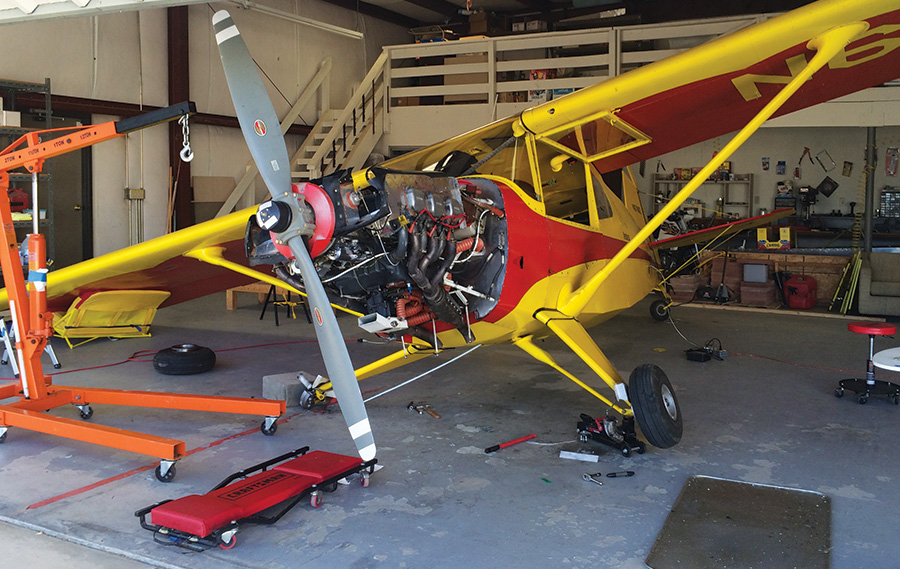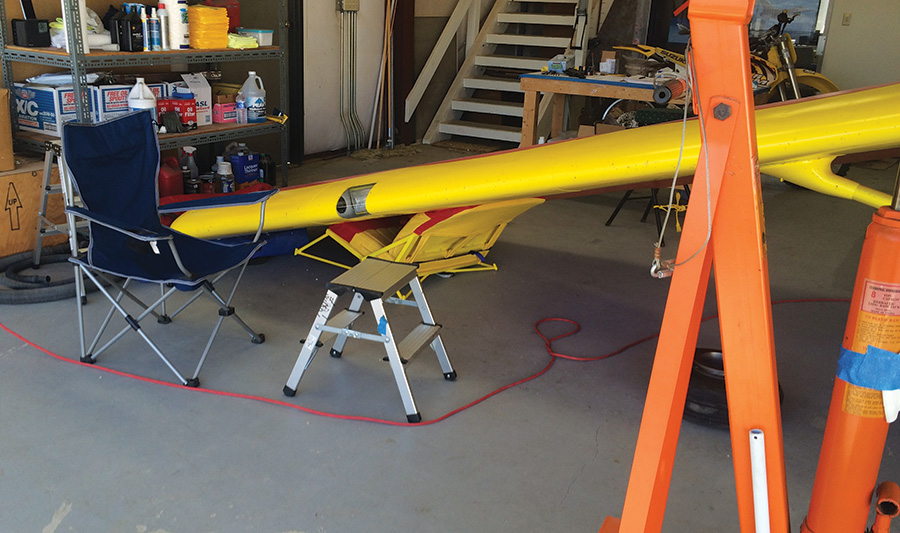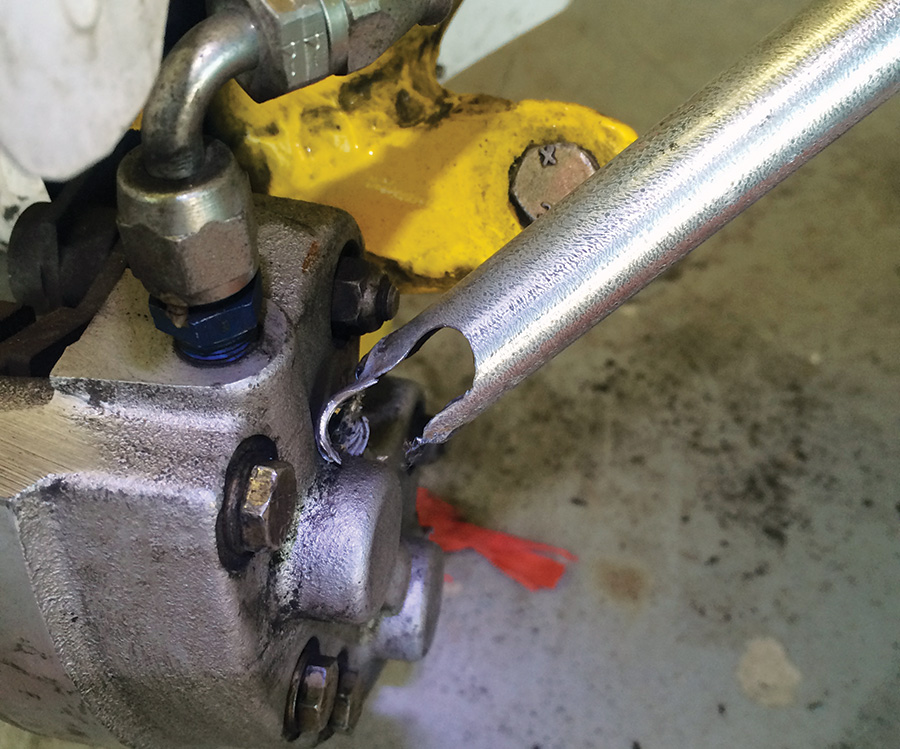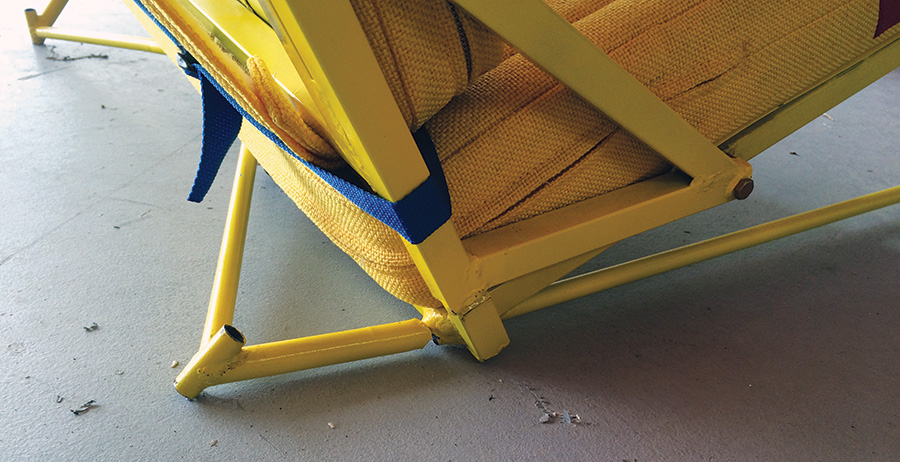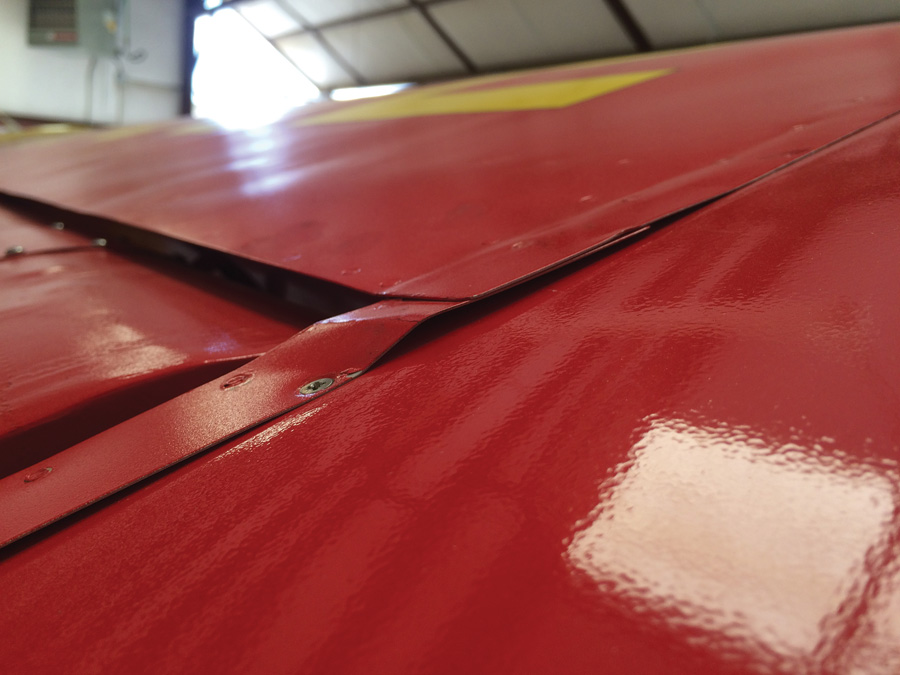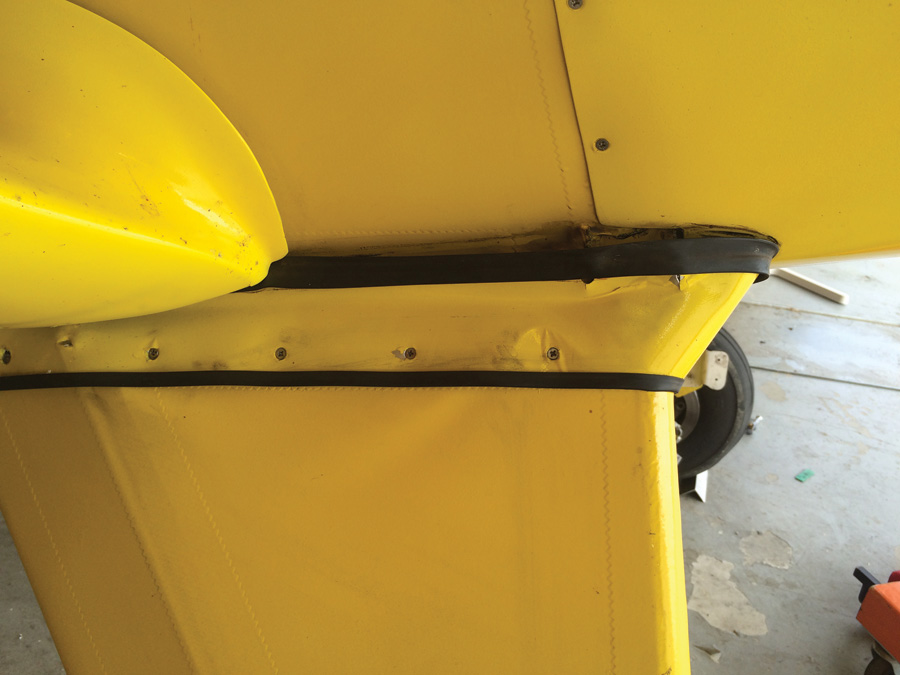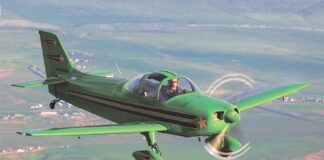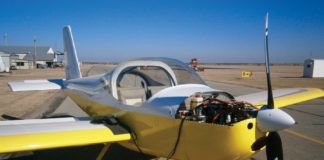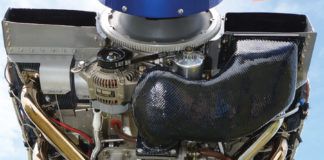It all started innocently enough…
For the last several years, my Bearhawk had a slow leak in the damper system of the right landing gear shock strut. Every time I would preflight, there would be a drop of automatic transmission fluid (ATF) hanging from the strut. The fluid was pressurized anytime the spring moved in the landing gear shock strut, so the leaks would appear after flying. There were no steady leaks if just left sitting.
ATF is fairly lightweight, so there’s no telling how much of it was left on the runway or just evaporated. I had started to notice some fluid in the fuselage above the shock strut attachment point, implying that the fluid was getting pushed out of the top of the strut. For my 2015 condition inspection, I decided to try to address the shock strut leak. I thought that the problem might be damaged O-rings in the shock strut, so I ordered up a new set.
On June 7, 2015, the seventh anniversary of the Bearhawk’s first flight, I set out to attempt a repair on the shock strut. I needed to use the shop crane to lift the fuselage so that there was no load on the right landing gear. Now, we have been told for years not to leave anything supported solely by a hydraulic jack because the hydraulic cylinders have a tendency to leak down with time. I have seen this happen, but it was over the course of days, not minutes. My solution was to replace the shock strut with a piece of electrical metallic tubing (EMT) conduit that had been used during the building process to hold the landing gear in place until the shock struts were fabricated.
The use of EMT for this purpose was officially endorsed by the designer (it said so right on the plans), but apparently only during the build process. This would let me set the aircraft down on its gear, and it would be happy while I serviced the shock strut. I lifted the fuselage, removed the shock strut, and replaced it with the EMT stand-in. All seemed to be going well.
Then I Got Greedy
I noticed my tires were sufficiently worn on the inside corners and decided it was time to remove the wheels and flip the tires the other way on the wheels so that they would rotate in the opposite direction and wear on the other corner. This is a time-honored approach to maximizing tire life with uneven tire wear. It was hot in the hangar, so I thought I would remove both wheels, leaving the axles on blocks, and flip the tires in the comfort of my air-conditioned garage while I was repairing the shock strut.
Convinced that the EMT was sufficient to take all of the loads, I removed the right wheel (since it was still off the ground) and lowered the axle onto a block that was 2-3 inches lower than the normal axle height. This caused the airplane to lean to the right, such that the wingtip was about 18 inches lower than normal. This right lean shifted more than half the weight of the airplane onto the right landing gear, further stressing the already overstressed EMT stand-in, which was never intended to hold the weight of the full airplane with engine, fuel, and everything else.
To remove the left wheel, I started jacking up the left landing gear. Instead of using the shop crane, I used a floor jack under the gear leg, as is the standard method for removing the wheel. I was sitting under the airplane to operate the jack. A couple of strokes on the jack and…bam!
What Just Happened?
I turned around to find the airplane lying on its right wingtip. The shock and surprise were immediate—sort of like being in a violent car accident that you never saw coming. I wasn’t touched physically, but emotionally, I had just taken a massive sucker punch.
Multiple things rushed through my head. Memories of bashing the right wingtip in a groundloop came to mind. Should I work immediately on getting the airplane back up? I figured everything was static at this point, so it wasn’t getting worse just sitting there. Working with about 2% of my brain capacity, I determined that I wasn’t injured in any way, so I got up and walked around to the right wingtip. Surprisingly, it wasn’t damaged like I expected.
I went back to the crane to lift the airplane up off the floor, and then decided I should get my phone and take some pictures; I knew I’d be talking about this. Again, it wasn’t getting any worse. Surprisingly, the pictures weren’t blurred even though my hands were shaking—worse than usual because of the shock.
I lowered the left landing gear down from the jack to get the tire back on the ground. I lowered the crane and hooked it up like it was originally, and started pumping the airplane back to a normal position. When the airplane was level again, I started assessing what had happened. The cause was when I started jacking up the left wheel, even more load was shifted to the right landing gear where the EMT conduit was already overloaded. This was more than the EMT could take, and the bolt sheared out of the EMT hole. Gravity did the rest.
A Miracle?
What happened next borders on the miraculous. You can decide where to put it on the pure-luck-to-divine-intervention scale, but the results are unmistakable. As part of the condition inspection, I had removed the rear seat and just plopped it on the floor under the right wing because there was room there. As it turns out, the rear seat took major damage to save the rest of the airplane. The positioning was absolutely perfect. As the wing fell, the first contact was on the corner of the seat back, with cushion between the wing and the seat back structure. The point of contact was directly under the rear spar, the second strongest place on the wing’s lower surface (the strongest being under the mainspar).
The amount of damage to the wing underside was further reduced by energy absorption from the bending of the rear seat structure and collapsing of the seat leg. As the seat back bent, the wing came into contact with more cushion until reaching the other corner of the seat back, which made another small dent in the wingskin. This force also tilted the seat back, such that another portion of the wingskin contacted the thick seat cushion at the front of the seat. This stopped the wing from falling just as the wingtip touched the floor.
There was no visible damage to the wingtip, at least no fractures requiring fiberglass work like after the groundloop. However, I suspect the wingtip did touch the floor, as there was a small buckling in the aluminum strip that attaches to the wingtip on the upper surface. Strangely, this was in the same location where similar damage happened during the groundloop.
There was no damage to the wingspars or twisting of the wing as evidenced by lack of waves in the wingskin. There were three small dents in the wingskin where it contacted the corners of the rear seat. These dents were small enough as to not warrant any sort of repair effort. They will most likely stand as reminders of gross buffoonery.
Because the gear leg was supported on the block, the block slid out, keeping the brake caliper mostly off of the floor. There was a small abrasion on the rubber cap covering the bleed valve, but no damage to the actual valve. The caliper was jammed sideways in the torque plate, but was easily freed with a few hammer taps.
The fairing at the top of the gear leg was significantly bent as it was jammed into the fuselage by the splaying gear leg. It looked like this part could be straightened to be used as a pattern to make a replacement part. A slight bend in the steel at the top of the gear leg seemed to have loosened the fabric on the gear leg slightly. Amazingly, the fuselage fabric was not damaged.
Almost a Prop Strike
Of significant note was that the propeller was still about 8 inches or more above the ground. Thus we know there was no prop strike or engine damage. Whew!
So now I was back to the original problem. My airplane was supported by a hydraulic jack that shouldn’t be left unmonitored. The only way to get the airplane safely standing up again was to reinstall the shock strut. If I just reinstalled the shock strut, I would have accomplished nothing but damaging the airplane. I needed to rework the shock strut, but the O-rings were at the house, not the hangar, since I had planned to do the rebuild there. Since I couldn’t be in both places at once, I called my wife Tuki and asked if she and our daughter Emily would come to the hangar and monitor the jack while I went home to expeditiously rebuild the shock strut.
Rebuilding
The first step was to remove the rod end bearing, which spun out of its threads very easily (smoking gun!). Since I didn’t have a -inch fine-thread bolt to use to compress the spring, and no time to go get one (it was past closing time at the hardware store), I used the drill press like an arbor press as I did when I originally assembled it. With pressure on the spring, I removed the snap ring and worked to pull out the spring package. I inspected the O-rings and found no damage on them whatsoever. Since I had it apart, I replaced the O-rings anyway.
I got to thinking about engineering service bulletins of the past. I had built my shock struts to the original plans, which called for fitting the shock strut with the spring compressed 1 inch. Later, as Bearhawks were being built heavier, the designer, Bob Barrows, changed the plans to fitting the shock strut with the spring compressed 1 3/8 inch. Another service bulletin called for shock struts built like mine to be shortened as much as possible. With the replacement rod end bearings, the only practical way to shorten the shock strut was to eliminate the jam nut on the rod end bearing and screw it in as far as possible. Unfortunately, it was the jam nut that pulled the rod end bearing threads up tight to form a seal to keep the hydraulic fluid inside the shock strut. The workaround was published in the service bulletin stating “The lock nut is not needed if Loctite (blue) is used on the threads.” Remembering how easily the rod end bearing had unscrewed and how clean the threads were, I concluded that I had failed to apply Loctite on the original assembly. Hence the now suspected source of the fluid leak—it was coming out around the threads!
A quick look around the shop found a tube of blue Loctite that had about four or five drops left in it. I took it and the reassembled shock strut back to the hangar where my wife and daughter were waiting. I applied the Loctite and reinstalled the shock strut before the Loctite could cure. I inserted the bolts at both ends, placed the washers on, and screwed on the nut far enough to make sure the bolt wouldn’t fall out. I lowered the crane to place the airplane back safely on its gear. With the airplane securely on its gear, I closed the hangar and went home before I inadvertently damaged something else.
What Can We Learn?
Other than sharing a traumatic event, what can we learn from this? One thing is that airplanes are rather unstable when jacking. As you jack up one side, the loads shift around, which leads to flexing of the landing gear and twisting of the fuselage with attendant disturbing sounds. Without a wheel on the gear axle, the gear is much less stable. This risk is manageable, but the risk goes up if you try to remove both mainwheels at the same time. The Cessna 180 service manual strongly discourages removing more than one wheel at a time.
Second is that EMT conduit is a suitable stand-in for the shock strut while building the fuselage and landing gear. However, it should not be considered suitable to support the full weight of the assembled airplane with stuff like wings and engine installed.
So after several days, with the benefit of 20-20 hindsight, how would I approach the same task? I would jack up the airplane the same way, remove the shock strut, and replace it with the EMT just like I did before. However, I would not have lowered the shop crane. Thus, the shop crane would still be supporting the airplane. If the hydraulic cylinder were to leak down, when the wheel touched the ground, the EMT would be able to support that small load and would lessen the load on the crane, slowing the leakdown. Even if the EMT were to overload and shear out, the crane would still be holding up the airplane. After replacing the shock strut, I would then remove the wheels one at a time to flip the tires.
Remember, we all learn from mistakes. The smart people have figured out how to learn from other people’s mistakes.
This Just In:
Jared Yates tells me that Bob Barrows now recommends securing the landing gear for shock strut servicing by stretching a come-a-long straight across from one wheel to the other, and then servicing one shock strut at a time. Jared did the same thing, but he used a very large ratchet strap. That would have been good for me to know.

